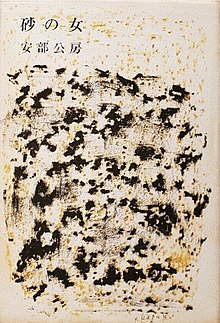
The Woman in the Dunes (Japanese: 砂の女, Hepburn: Suna no Onna, lit. "Sand Woman") is a novel by the Japanese writer Kōbō Abe, published in 1962. It won the 1962 Yomiuri Prize for literature, and an English translation by E. Dale Saunders, and a film adaptation, directed by Hiroshi Teshigahara, appeared in 1964.
The novel is intended as a commentary on the claustrophobic and limiting nature of existence, as well as a critique of certain aspects of Japanese social behavior. The story is preceded by the aphorism "Without the threat of punishment there is no joy in flight."
Plot
In 1955, Jumpei Niki, a school teacher from Tokyo, visits a fishing village to collect insects. After missing the last bus, he is led by the villagers, in an act of apparent hospitality, to a house in the dunes that can be reached only by rope ladder. The next morning the ladder is gone and he finds he is expected to keep the house clear of sand with the woman living there, with whom he is also to produce children. He ultimately finds a way to collect water which gives him a purpose and a sense of liberty. He also wants to share the knowledge of his technique of water collection with the villagers someday. He eventually gives up trying to escape when he comes to realize that returning to his old life would give him no more liberty. He accepts his new identity and family. After seven years, he is proclaimed officially dead. (In the original Japanese version, he is proclaimed officially as a missing person.)
Publication, reception, and legacy
The book attracted much attention in Japan on its publication in 1962, earning praise from critics as well as contemporaries such as Kenzaburō Ōe and Yukio Mishima. It won that year's Yomiuri Prize for literature. An English translation appeared in 1964, as did a film adaptation directed by Hiroshi Teshigahara starring Eiji Okada and Kyōko Kishida which won the Special Jury Prize at the 1964 Cannes Film Festival.
References
- Allinson, Gary D. (1999). The Columbia guide to modern Japanese history. Internet Archive. New York : Columbia University Press. ISBN 978-0-231-11144-7.
- Abe, Kobo (1972). The woman in the dunes. Internet Archive. New York, Vintage Books. ISBN 978-0-394-71814-9.
- ^ O'Neil 2004, p. 16.
- ^ Treat 1994, p. 457.
Works cited
- O'Neil, Patrick M., ed. (2004). "Abe Kōbō". Great World Writers: Twentieth Century. Vol. 1. Marshall Cavendish.
- Treat, John Whittier (1994). "The Woman in the Dunes". In Miller, Barbara Stoler (ed.). Masterworks of Asian Literature in Comparative Perspective. A Guide for Teaching. Sharpe. pp. 457–469. ISBN 9780765631657.
Further reading
- Dissanayake, Wimal (1990). "Self, Place and Body in The Woman in the Dunes". In Toyama, J.; Ochner, N. (eds.). Literary Relations East and West. Vol. 3. University of Hawaii at Manoa Press. ISBN 9780824813246.
- Kimball, Arthur G. (1962). "Identity Found: Suna no onna". Crisis in Identity and the Contemporary Japanese Novel. Tuttle.
External links
 Quotations related to The Woman in the Dunes at Wikiquote
Quotations related to The Woman in the Dunes at Wikiquote- The Woman in the Dunes at the Internet Archive